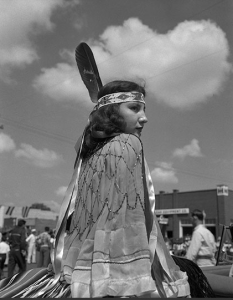Photographer
 Horace was born in Mountain View, Oklahoma on March 13, 1906, the son of George and Tsomah Poolaw. His father was a known historian who maintained a calendar of significant yearly events of the Kiowa life in a pictograph format, painted on buckskins. This traditional background caused Horace to seek a means of recording the Southern Plains tribes’ fast changing pace of life.
Horace was born in Mountain View, Oklahoma on March 13, 1906, the son of George and Tsomah Poolaw. His father was a known historian who maintained a calendar of significant yearly events of the Kiowa life in a pictograph format, painted on buckskins. This traditional background caused Horace to seek a means of recording the Southern Plains tribes’ fast changing pace of life.
He tried painting but turned to photography and began working with a local photographer named George Long around 1926. Here he learned the fundamentals of outdoor photography and darkroom techniques. George Long sold his studio to John Coyle, from whom Poolaw learned the finer points of
portrait photography. Horace finished his own photographic education with a correspondence course in photo oil coloring
His Grandmother was one of his first models, posing for a series of photos wearing her rare Ghost Dance dress. He continued to photograph dances &
social events of the Southern Plains Indians that were for their own culture and not the entertainment of outsiders. During his career, he was able to photograph notable leaders of the Comanche, Cheyenne, Arapaho, Apache, Caddo and Delaware tribes, along with visitors from the Pueblo and other Southwestern tribes.
During World War II, he joined the U.S. Amy Air Corps becoming an instructor for aerial photography, and training bomber crews to use cameras for documentation of their bombing missions. He was the only American Indian of his generation to be recognized as a professional photographer.
Horace Poolaw has given us a photographic record of the huge transition the Plains Indians went through, from a Native American perspective. He spans an ear from the last survivors of the Southern Plains Indian Wars to the returning Vietnam veterans.
Horacce died in 1984 but his work was still being shown in exhibitions such as “Kiowa Culture in Transition”, exhibited at the Heard Museum in October 1993.